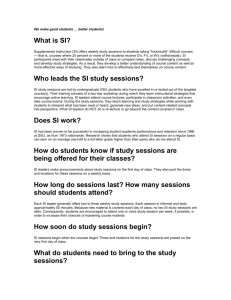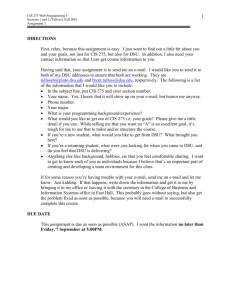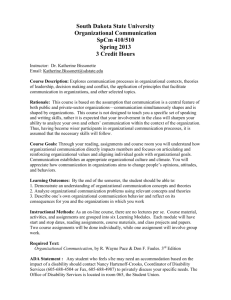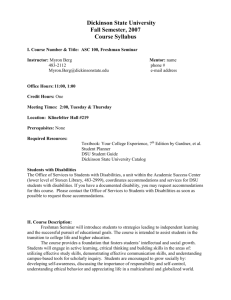LT 741: COURSE SYLLABUS
advertisement
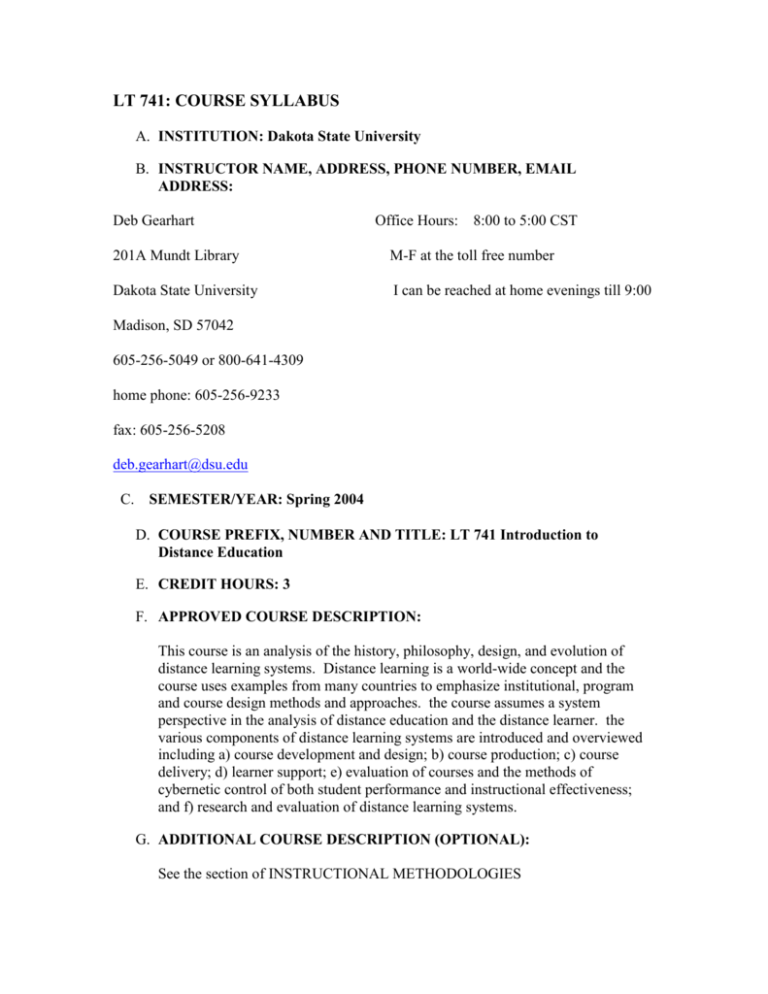
LT 741: COURSE SYLLABUS A. INSTITUTION: Dakota State University B. INSTRUCTOR NAME, ADDRESS, PHONE NUMBER, EMAIL ADDRESS: Deb Gearhart Office Hours: 8:00 to 5:00 CST 201A Mundt Library M-F at the toll free number Dakota State University I can be reached at home evenings till 9:00 Madison, SD 57042 605-256-5049 or 800-641-4309 home phone: 605-256-9233 fax: 605-256-5208 deb.gearhart@dsu.edu C. SEMESTER/YEAR: Spring 2004 D. COURSE PREFIX, NUMBER AND TITLE: LT 741 Introduction to Distance Education E. CREDIT HOURS: 3 F. APPROVED COURSE DESCRIPTION: This course is an analysis of the history, philosophy, design, and evolution of distance learning systems. Distance learning is a world-wide concept and the course uses examples from many countries to emphasize institutional, program and course design methods and approaches. the course assumes a system perspective in the analysis of distance education and the distance learner. the various components of distance learning systems are introduced and overviewed including a) course development and design; b) course production; c) course delivery; d) learner support; e) evaluation of courses and the methods of cybernetic control of both student performance and instructional effectiveness; and f) research and evaluation of distance learning systems. G. ADDITIONAL COURSE DESCRIPTION (OPTIONAL): See the section of INSTRUCTIONAL METHODOLOGIES H. PREREQUISITES: None I. ADDITIONAL COURSE INFORMATION: ADA STATEMENT: If there is any student who has special needs for accommodation, please feel free to discuss the matter with the instructor. Students requiring accommodations need to contact Dr. Robert Jackson, the DSU ADA Academic Coordinator. He can be reached at (605) 256-5823 or toll free at (800) 641-4309 or robert.jackson@.dsu.edu. The ADA Office is located in the Student Services Office in the Trojan Center on the Madison Campus. J. POLICIES AND PROCEDURES: 1. Assignments: Assignments should be completed on time, especially assigned responsibilities in any group project and team work. Any delay may affect the course evaluation. Please contact the instructor if you know in advance you will be delayed, out of town, etc. 2. Academic Honesty: All written work by students should be the result of the individual student's research, thought, preparation, and writing efforts. Plagiarism and work that is prepared by others outside of the enrolled class and submitted as original work by the student will result in a failing grade for the course. The DSU Academic Integrity Board Policy 04-05-00 is available online at http://www.departments.dsu.edu/hr/newsite/policies/040500.htm. please be advised that when the instructor suspects plagiarism, the Internet and other standard means of plagiarism detection will be used to resolve the instructor's concern. K. TEXTBOOK AND OTHER REFERENCES: Required Textbooks: Teaching and Learning at a Distance – Foundations of Distance Education. 2nd ed. Michael Simonson, et al. Prentice Hall, Inc., 2003. ISBN # 0-13-094629-X. Distance Learning - Making Connections Across Virtual Space and Time, 1st edition. Anthony Picciano, Prentice Hall, Inc., 2000. ISBN # 0-13-080900-4 Supplemental Texts: Moore, M. G., and Kearsley, G. (1996). Distance Education A Systems View, Belmont, LA: Wadsworth Publishing Co. Cyrs, T. E. (1997). Teaching at a Distance with the Merging Technologies. (with E. D. Conway). Las Cruces, NM: Center for Educational Development at New Mexico State University. Cyrs, T. E. (1997). Teaching and Learning at a Distance: What it Takes to Effectively Design, Deliver, and Evaluate Programs. New Directions for Teaching and Learning. Number 71, Fall 1997. Jossey-Bass Publishers. Brad Cahoon, Ed. Adult Learning and the Internet. (1998). New directions for Adult and Continuing Education, No. 78. San Francisco, CA: Jossey-Bass Publishers. K. COMPUTER EQUIPMENT & SKILLS NEEDED: Computer Requirements Operating System Computer Processor Computer Memory Hard Disk Space Modem / Internet Access Mac O/S 8 or 9, Windows 95/98/NT, Unix Intel® Pentium® III or higher 64 MB (megabytes) of RAM 40 MB (megabytes), variable 56kbps recommended Web Browser Microsoft Internet Explorer 5 Netscape Navigator 4 or Netscape 6 L. CORE OBJECTIVES: This course is designed to enable students to: 1. Evaluate the strengths, weaknesses, and options associated with various technologies for delivery (SoE D, A;NCATE 1.F.1) 2. Describe considerations and procedures associated with the delivery system for major distance activities: technical support, course design/development, teaching/tutoring, student interface, and administration services (SoE D; NCATE 1.F.1, 1.G.1). 3. Conduct, Experience, and evaluate a variety of teaching techniques in interactive television and Web-based instruction (SoE D; NCATE 1.G.1) 4. Prepare for or enhance a professional role they have in an education program that uses the technology, such as technician, course developer, instructor, evaluator, coordinator of student services, or administrator (SoE D; NCATE 1.G.1). M. ADDITIONAL OBJECTIVES (OPTIONAL): 1. Develop a general knowledge of distance learning's past, present and possible future, and be aware of the political, socio-economic, and technological factors that help shape the status of distance learning systems. Be able to describe and discuss the above. 2. Be able to relate learning theory to distance learning practice. Compare and critique instructional models for adoption and adaptation in distance learning settings. 3. Describe and discuss the information attributes of different media in terms of their cognitive relevance and instructional values for different learners in different subject-matter areas. 4. Describe and critique the non-linearity of hypermedia and its potential cognitive advantages and common pitfalls, and be able to use at lease one popular Web development tool in instructional hypermedia development. 5. Be able to use both synchronous and asynchronous tools for class interaction and management, including BBS and email. 6. Be able to discuss the human factors issues surrounding the selection and use of synchronous and asynchronous instructional delivery tools. 7. Be aware of the test validity issues in distance learning and describe the strategies and techniques available to enhance test validity in distance learning. N. INSTRUCTIONAL METHODOLOGIES: 1. Delivery: This course will be delivered over the Internet with lessons demonstrating other distance education technologies. Students proceed through a course of study as directed and assisted by computer technology. Mastery is based on achieving competencies and benchmarks. 2. Readings: Core textbooks are distributed in printed hard copy. Supplementary readings are provided on the Web. 3. Class Interaction: Email exchange and discussion/bulletin board will be used to provide a forum for asynchronous class interaction.. Discussion and interaction at the graduate level is important and all students will be expected to participate. Communication with the instructor is by email or phone. 4. Pedagogy: Student-centered, constructive, collaborative and engaged learning will be the principal approach used in this course. Students are encouraged to be responsible for their own learning. Guidance will be provided to promote students' intrinsic motivation and develop a strategic approach to both learning and teaching in distance education. O. COURSE OUTLINE: Week Topics Assignments Activities Week 1 (1/9 - 1/18) Unit 1 Foundations of Distance Education S. Chap. 1 & 2 Introductions P. Chap. 1 Discussion Board Discussion Board Week 2 (1/19– 1/25) Unit 1 Foundations of Distance Education Week 3 (1/26 – 2/1) Unit 2 Understanding S. Chap. 3 the Systems Approach to Distance Education P. Chap 2 Week 4 (2/2 – 2/8) Week 5 (2/9 – 2/15) Week 6 (2/16 – 2/22) Unit 2 Understanding the Systems Approach to Distance Education Unit 3 Distance Education Technologies Unit 4 Instructional Design S. Chap. 4 P. Chap. 3 S. Chap. 5, 6, 9, 11, 12 Discussion Board Topic for position paper due 2/2 Discussion Board Article or site critique due 2/9 Discussion Board Discussion Board S. Chap. 4, 8 Guide on p. 209 Week 7 (2/23 – 3/1) Unit 4 Instructional Design Discussion Board Design Exercise due 3/2 Position Paper due 3/9 Discussion Board Spring Break (3/2 – 3/8) Week 8 (3/9 – 3/15) Unit 4 Instructional Design Week 9 (3/16 – 3/22) Unit 5 The Distance Education Student Week 10 (3/23 – 3/29) Unit 6 Teaching at a Distance Week 11 (3/30 – 4/5) Week 12 (4/6 – 4/12) Unit 6 Teaching at a Distance Unit 7 Distance Education and the Web Unit 7 Distance Education and the Web Course Wrap-up S. Chap. 7 Discussion Board P. Chap. 5 S. Chap. 8 Discussion Board P. Chap. 6 Week 13 (4/13 – 4/19) Week 14 (4/20 – 4/26) Discussion Board S. Chap. 10 Discussion Board P. Chap. 7 & 9 Discussion Board Week 15 (4/27 – 5/3) Final Project S. Simonson, et al. text Final project due 5/2 P. Picciano text P. EVALUATION PROCEDURES: Course evaluation will be based on an integrated consideration of the following components: 1. 2. 3. 4. Participation = 20% Assignments = 20% Term Paper = 30% Term Project = 30% The term paper is due by spring break. The paper is a position paper, 10-12 pages double spaced. The topic of your paper is due by February 1. The term project is due by May 3. The project requires each student to integrate course-related knowledge, theory, application skills, and experiences in a coordinated effort. The project must have instructor approval but is open to all possibilities. Q. SELECTED BIBLIOGRAPHY/RESEARCH AND BEST PRACTICES: The knowledge bases that support course content and procedures include: 1. Contemporary References (1990-1997) Burge, Z.L. & Collins, M.P. (Eds.) (1997). Wired Together: Computer-mediated communication in K-12. (Vols. 1-4) Cresskill, NJ: Hampton Press. Eastmond, D.E. (1995). Alone but together: Adult distance study through computer conferencing. Cresskill, NJ: Hampton Press. Keegan, D. (1990). Online education: Perspectives on a new environment. New York, NY: Praeger. Rossman, M.H. & Rossman, M.E. (Eds.). (1995). Facilitating Distance Education (New Directions for Adult and Continuing Education, No 67). San Francisco, CA: Jossey-Bass. Willis, B. (1993). Distance education: A practical guide. Englewood Cliffs, NJ: Educational Technology Publications. Willis B. (1994). Distance education: Tools and strategies. Englewood Cliffs, NJ: Educational Technology Publications. 2. Key Journals American Journal of Distance Education Educational Technology Research & Development Tech Trends Educational Technology Distance Education (Australia) Journal of Distance Education (Canadian) Distance Education Report R. FIELD/CLINICAL EXPERIENCES (FOR PROFESSIONAL EDUCATION COURSES ONLY): S. RELATION TO MISSION (FOR PROFESSIONAL EDUCATION COURSES ONLY): T. GRADUATE NATURE (GRADUATE COURSES ONLY): Participants will research, discuss, and apply current pedagogy on effective integration of distance education technologies in the teaching and learning process. Participants will reflect on changes in pedagogy based on the results of application of new technologies in the classroom. Participants are provided the theoretical and technical background to conduct research and design coursework using distance education technologies. Important Links: Library http://www.departments.dsu.edu/library/distance.htm Policies Student Handbook http://www.departments.dsu.edu/student_services/handbook/ E-Education Services Student Guide http://www.departments.dsu.edu/disted/studentguide/guide.htm Campus Policies http://www.departments.dsu.edu/registrar/catalog/undergraduate/AcademicPolicies /academic_policies.htm DSU Bookstore http://www.dsubookstore.com/ Computer Services Support http://support.dsu.edu/ Ordering Transcripts http://www.departments.dsu.edu/registrar/transcripts.htm Home

